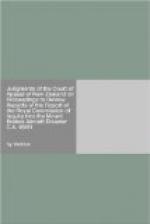“In my opinion, the introduction of the word ‘McMurdo’ into the Air Traffic Control flight plan for the fatal flight was deliberately designed to conceal from the United States authorities that the flight path had been changed, and probably because it was known that the United States Air Traffic Control would lodge an objection to the new flight path.”
It will be observed that the last few words are qualified by “probably”. It appears that the Commissioner was told during a visit to Antarctica that the United States authorities would not have approved a flight path over Ross Island. But there was no evidence that Air New Zealand had ever received an intimation from the United States authorities to that effect or that the navigation section had reason to think they would so object. The qualification seems to reflect that position. In the result, when the findings in the two sub-paragraphs 255 (e) and (f) are put together they reveal the theory that at one at the same time the navigation section felt obliged to conceal from officials in Wellington the use of a flight track down McMurdo Sound that was regarded favourably by officials at McMurdo Station and from officials at McMurdo Station a flight track over Ross Island that was regarded favourably by officials in Wellington.
Whiteout
In relation to the cover-up allegations that have been made against the executive officers some reference should be made to their knowledge or otherwise of the freak meteorological condition known as “the whiteout phenomenon”. Did they know or suspect that such a condition must have been an explanation for what happened and yet still be determined as the Commissioner found, to promote pilot error as the cause of the crash?
It is something that can be mentioned quite briefly. The Royal Commission Report has made it clear the phenomenon can result in a loss of horizon definition and depth perception and is a great hazard for those who fly in arctic or antarctic conditions. The Commissioner found that at the critical time “air crew had been deceived into believing that the rising white terrain ahead was in fact quite flat and that it extended on for many miles under the solid overcast”. This danger is something well known to those who fly regularly in those areas. Unfortunately it is not so well known by others, and as the Commissioner stated in paragraph 165 it was not understood by any of those involved in this case. He said:
“So far as I understand the evidence, I do not believe that either the airline or Civil Aviation Division ever understood the term ‘whiteout’ to mean anything else than a snowstorm. I do not believe that they were ever aware, until they read the chief inspector’s report, of the type of ‘whiteout’ which occurs in clear air, in calm conditions, and which creates this visual illusion which I have previously described and which is, without doubt, the most dangerous of all polar weather phenomena.”
It would seem that if those at airline headquarters were unaware of the deceptive dangers of the whiteout phenomenon they could not have deliberately ignored it as a factor that should be taken into account in favour of the aircrew.




